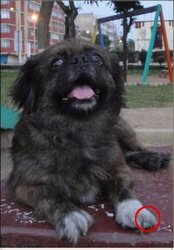Remapping {#tutorial_remap}
@tableofcontents
@prev_tutorial{tutorial_hough_circle} @next_tutorial{tutorial_warp_affine}
| | | | -: | :- | | Original author | Ana Huamán | | Compatibility | OpenCV >= 3.0 |
Goal
In this tutorial you will learn how to:
a. Use the OpenCV function @ref cv::remap to implement simple remapping routines.
Theory
What is remapping?
- It is the process of taking pixels from one place in the image and locating them in another position in a new image.
- To accomplish the mapping process, it might be necessary to do some interpolation for non-integer pixel locations, since there will not always be a one-to-one-pixel correspondence between source and destination images.
We can express the remap for every pixel location \f$(x,y)\f$ as:
\f[g(x,y) = f ( h(x,y) )\f]
where \f$g()\f$ is the remapped image, \f$f()\f$ the source image and \f$h(x,y)\f$ is the mapping function that operates on \f$(x,y)\f$.
Let's think in a quick example. Imagine that we have an image \f$I\f$ and, say, we want to do a remap such that:
\f[h(x,y) = (I.cols - x, y )\f]
What would happen? It is easily seen that the image would flip in the \f$x\f$ direction. For instance, consider the input image:

observe how the red circle changes positions with respect to x (considering \f$x\f$ the horizontal direction):

In OpenCV, the function @ref cv::remap offers a simple remapping implementation.
Code
- What does this program do?
- Loads an image
- Each second, apply 1 of 4 different remapping processes to the image and display them indefinitely in a window.
- Wait for the user to exit the program
@add_toggle_cpp
- The tutorial code's is shown lines below. You can also download it from here @include samples/cpp/tutorial_code/ImgTrans/Remap_Demo.cpp @end_toggle
@add_toggle_java
- The tutorial code's is shown lines below. You can also download it from here @include samples/java/tutorial_code/ImgTrans/remap/RemapDemo.java @end_toggle
@add_toggle_python
- The tutorial code's is shown lines below. You can also download it from here @include samples/python/tutorial_code/ImgTrans/remap/Remap_Demo.py @end_toggle
Explanation
Load an image:
@add_toggle_cpp @snippet samples/cpp/tutorial_code/ImgTrans/Remap_Demo.cpp Load @end_toggle
@add_toggle_java @snippet samples/java/tutorial_code/ImgTrans/remap/RemapDemo.java Load @end_toggle
@add_toggle_python @snippet samples/python/tutorial_code/ImgTrans/remap/Remap_Demo.py Load @end_toggle
Create the destination image and the two mapping matrices (for x and y )
@add_toggle_cpp @snippet samples/cpp/tutorial_code/ImgTrans/Remap_Demo.cpp Create @end_toggle
@add_toggle_java @snippet samples/java/tutorial_code/ImgTrans/remap/RemapDemo.java Create @end_toggle
@add_toggle_python @snippet samples/python/tutorial_code/ImgTrans/remap/Remap_Demo.py Create @end_toggle
Create a window to display results
@add_toggle_cpp @snippet samples/cpp/tutorial_code/ImgTrans/Remap_Demo.cpp Window @end_toggle
@add_toggle_java @snippet samples/java/tutorial_code/ImgTrans/remap/RemapDemo.java Window @end_toggle
@add_toggle_python @snippet samples/python/tutorial_code/ImgTrans/remap/Remap_Demo.py Window @end_toggle
Establish a loop. Each 1000 ms we update our mapping matrices (mat_x and mat_y) and apply them to our source image:
@add_toggle_cpp @snippet samples/cpp/tutorial_code/ImgTrans/Remap_Demo.cpp Loop @end_toggle
@add_toggle_java @snippet samples/java/tutorial_code/ImgTrans/remap/RemapDemo.java Loop @end_toggle
@add_toggle_python @snippet samples/python/tutorial_code/ImgTrans/remap/Remap_Demo.py Loop @end_toggle
The function that applies the remapping is @ref cv::remap . We give the following arguments:
- src: Source image
- dst: Destination image of same size as src
- map_x: The mapping function in the x direction. It is equivalent to the first component of \f$h(i,j)\f$
- map_y: Same as above, but in y direction. Note that map_y and map_x are both of the same size as src
- INTER_LINEAR: The type of interpolation to use for non-integer pixels. This is by default.
- BORDER_CONSTANT: Default
How do we update our mapping matrices mat_x and mat_y? Go on reading:
Updating the mapping matrices: We are going to perform 4 different mappings: -# Reduce the picture to half its size and will display it in the middle: \f[h(i,j) = ( 2 \times i - src.cols/2 + 0.5, 2 \times j - src.rows/2 + 0.5)\f] for all pairs \f$(i,j)\f$ such that: \f$\dfrac{src.cols}{4}
This is expressed in the following snippet. Here, map_x represents the first coordinate of h(i,j) and map_y the second coordinate.
@add_toggle_cpp @snippet samples/cpp/tutorial_code/ImgTrans/Remap_Demo.cpp Update @end_toggle
@add_toggle_java @snippet samples/java/tutorial_code/ImgTrans/remap/RemapDemo.java Update @end_toggle
@add_toggle_python @snippet samples/python/tutorial_code/ImgTrans/remap/Remap_Demo.py Update @end_toggle
Result
-# After compiling the code above, you can execute it giving as argument an image path. For instance, by using the following image:

-# This is the result of reducing it to half the size and centering it:

-# Turning it upside down:

-# Reflecting it in the x direction:

-# Reflecting it in both directions:

